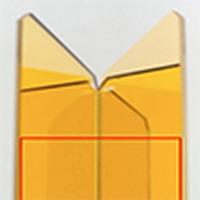当前位置:
X-MOL 学术
›
J. Opt. Soc. Am. A
›
论文详情
Our official English website, www.x-mol.net, welcomes your feedback! (Note: you will need to create a separate account there.)
Angular reflectance model for ridged specular surfaces, with comprehensive calculation of inter-reflections and polarization.
Journal of the Optical Society of America A ( IF 1.9 ) Pub Date : 2019-11-01 , DOI: 10.1364/josaa.36.000c51 Dorian Saint-Pierre , Pierre Chavel , Lionel Simonot , Mathieu Hébert
Journal of the Optical Society of America A ( IF 1.9 ) Pub Date : 2019-11-01 , DOI: 10.1364/josaa.36.000c51 Dorian Saint-Pierre , Pierre Chavel , Lionel Simonot , Mathieu Hébert

|
The color of a surface structured at the mesoscopic scale differs from the one of a flat surface of the same material because of the light inter-reflections taking place in the concavities of the surface, as well as shadowing effects. The color variation arises not only in scattering materials, but also in the absence of scattering, e.g., in metals and clear dielectrics, just as a consequence of multiple specular reflections between neighboring flat facets of the surface. In this paper, we investigate such color variation in the case of an infinitely long V-shaped groove, having in mind the visual appearance of a surface composed of many structures of that sort, all parallel and identical. We develop a full model of multiple specular reflections, accounting for the ray position and orientation and the polarization effects occurring at each reflection. We compare that situation with two approximate models, more usual and easier to compute, where light is assumed to remain unpolarized all along, or where the $p$p- and $s$s-polarized components are treated separately. Spectral reflectances were predicted for various materials and angles of cavities, under diffuse illumination. In most cases, the three models predict very similar bi-hemispherical reflectances, but the hemispherical-directional reflectances can vary noticeably in certain observation directions. This study might help achieve a more physically realistic rendering of dielectric or metallic ridged surfaces in computer graphics.
中文翻译:

脊形镜面曲面的角反射模型,综合计算了相互反射和偏振。
在介观尺度上构造的表面的颜色不同于同一材料的平坦表面的颜色,这是由于在表面的凹面中发生的光相互反射以及阴影效应。不仅在散射材料中,而且在没有散射的情况下,例如在金属和透明电介质中,都会出现颜色变化,这是表面相邻平坦小平面之间多次镜面反射的结果。在本文中,我们在无限长的V形凹槽的情况下研究这种颜色变化,同时考虑到由许多此类平行且相同的结构组成的表面的视觉外观。我们开发了多种镜面反射的完整模型,考虑到光线的位置和方向以及每次反射时发生的偏振效应。我们将这种情况与两个近似模型进行比较,这两个模型更常见且更易于计算,其中假定光线始终保持非偏振状态,或者分别对待$ p $ p-和$ s $ s偏振分量。可以预测在漫射照明下各种材料和腔体角度的光谱反射率。在大多数情况下,这三个模型预测的双半球反射率非常相似,但半球方向的反射率在某些观察方向上可能会发生明显变化。这项研究可能有助于实现计算机图形学中介电或金属脊表面的更物理逼真的渲染。假定光线始终保持非偏振状态,或者分别处理$ p $ p和$ s $ s偏振分量的位置。可以预测在漫射照明下各种材料和腔体角度的光谱反射率。在大多数情况下,这三个模型预测的双半球反射率非常相似,但是在某些观察方向上,半球方向的反射率会发生明显变化。这项研究可能有助于实现计算机图形学中介电或金属脊表面的更物理逼真的渲染。假定光线始终保持非偏振状态,或者分别处理$ p $ p和$ s $ s偏振分量的位置。可以预测在漫射照明下各种材料和腔体角度的光谱反射率。在大多数情况下,这三个模型预测的双半球反射率非常相似,但半球方向的反射率在某些观察方向上可能会发生明显变化。这项研究可能有助于实现计算机图形学中介电或金属脊表面的更物理逼真的渲染。这三个模型预测的双半球反射率非常相似,但在某些观察方向上,半球方向的反射率会发生明显变化。这项研究可能有助于实现计算机图形学中介电或金属脊表面的更物理逼真的渲染。这三个模型预测的双半球反射率非常相似,但在某些观察方向上,半球方向的反射率会发生明显变化。这项研究可能有助于实现计算机图形学中介电或金属脊表面的更物理逼真的渲染。
更新日期:2019-11-04
中文翻译:

脊形镜面曲面的角反射模型,综合计算了相互反射和偏振。
在介观尺度上构造的表面的颜色不同于同一材料的平坦表面的颜色,这是由于在表面的凹面中发生的光相互反射以及阴影效应。不仅在散射材料中,而且在没有散射的情况下,例如在金属和透明电介质中,都会出现颜色变化,这是表面相邻平坦小平面之间多次镜面反射的结果。在本文中,我们在无限长的V形凹槽的情况下研究这种颜色变化,同时考虑到由许多此类平行且相同的结构组成的表面的视觉外观。我们开发了多种镜面反射的完整模型,考虑到光线的位置和方向以及每次反射时发生的偏振效应。我们将这种情况与两个近似模型进行比较,这两个模型更常见且更易于计算,其中假定光线始终保持非偏振状态,或者分别对待$ p $ p-和$ s $ s偏振分量。可以预测在漫射照明下各种材料和腔体角度的光谱反射率。在大多数情况下,这三个模型预测的双半球反射率非常相似,但半球方向的反射率在某些观察方向上可能会发生明显变化。这项研究可能有助于实现计算机图形学中介电或金属脊表面的更物理逼真的渲染。假定光线始终保持非偏振状态,或者分别处理$ p $ p和$ s $ s偏振分量的位置。可以预测在漫射照明下各种材料和腔体角度的光谱反射率。在大多数情况下,这三个模型预测的双半球反射率非常相似,但是在某些观察方向上,半球方向的反射率会发生明显变化。这项研究可能有助于实现计算机图形学中介电或金属脊表面的更物理逼真的渲染。假定光线始终保持非偏振状态,或者分别处理$ p $ p和$ s $ s偏振分量的位置。可以预测在漫射照明下各种材料和腔体角度的光谱反射率。在大多数情况下,这三个模型预测的双半球反射率非常相似,但半球方向的反射率在某些观察方向上可能会发生明显变化。这项研究可能有助于实现计算机图形学中介电或金属脊表面的更物理逼真的渲染。这三个模型预测的双半球反射率非常相似,但在某些观察方向上,半球方向的反射率会发生明显变化。这项研究可能有助于实现计算机图形学中介电或金属脊表面的更物理逼真的渲染。这三个模型预测的双半球反射率非常相似,但在某些观察方向上,半球方向的反射率会发生明显变化。这项研究可能有助于实现计算机图形学中介电或金属脊表面的更物理逼真的渲染。


























 京公网安备 11010802027423号
京公网安备 11010802027423号